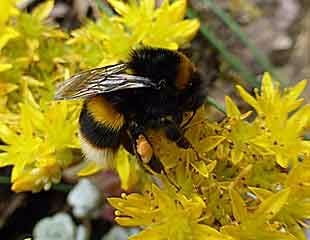
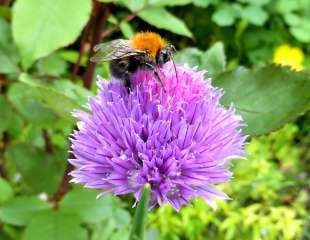
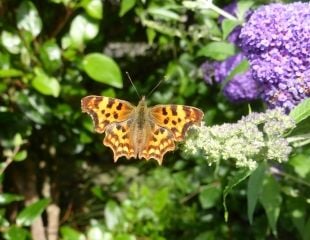
The 10 best plants for Bees and Butterflies
Here are some ideas about the best garden plants to attract bees and butterflies into your garden. All are easy to grow and maintain, introducing colour, diversity and pollinators into your garden.
Alliums and Chives
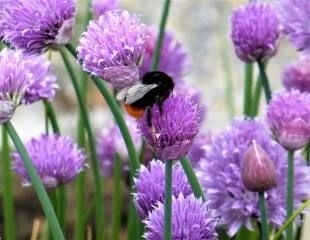
Bees love all members of the Allium family. Grow a clump of alliums or chives and have a clump of bees!
Both are suitable for growing in a container for patios/balconies.
One variety that attracts lots of bees and butterflies is Allium nutans, also known as Siberian Chives.
This video shows it all: a mass of insects all over the chives. Alliums are easy-to-grow flowering bulbs: more info, images and growing tips.
Bee Friendly onions
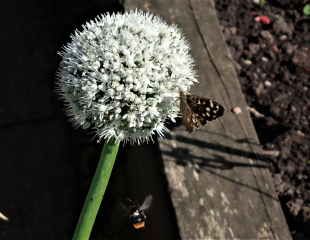
Sometimes onions produce flowers in a process known as bolting. You can try to stop onions from bolting, but I let nature do its thing as the flowers are attractive.
The bees and butterflies love them.
There is another short video showcasing the attraction of onions; take a moment to watch busy bees in nature.
I could write so much about the Allium family, enough to say they are a great garden plant for pollinators
Sedum
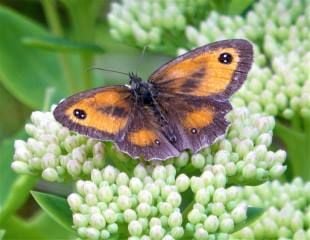
Sedum is a top plant for bees and butterflies. It is no exaggeration that on a warm, sunny day, Sedums may attract half a dozen butterflies, countless bees and pollinators. If you have room in your garden for only one plant to attract pollinators, I recommend Sedum.
Sedum is an easy-to-grow, late summer-flowering perennial.
The short video below shows butterflies irresistibly drawn to Sedum, especially the white variety Sedum Hylotelephium spectabile 'Stardust' (available from Crocus via this link)
Geranium
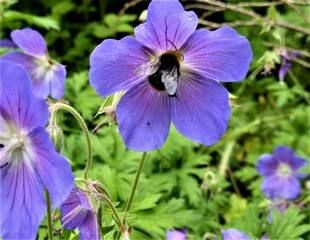
Geraniums are bee-friendly, but this is especially true of the blue varieties because bees love blue (which is based on good science). Here is a short, relaxing video of bees and geraniums. Close your eyes and slip back to a warm sunny day, birdsong and bees
There is a wide range of Geraniums in the group, all easy to grow, the blue and purple varieties are best for the bees. with fresh new growth each spring. Geraniums require no maintenance and will form a good-sized clump in a short space of time. Suitable for containers.
Verbena
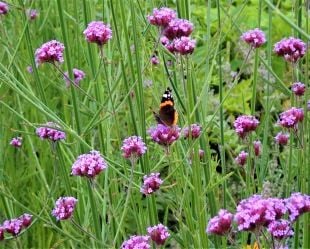
Verbena is a fabulous perennial for bees and butterflies, with the added benefit that it flowers for weeks, providing a sustained source of nectar.
During the not particularly good summer of 2023, I've had Verbena in flower from July until October. During this entire time, it was visited by a constant stream of pollinators. It's a plant loved by wildlife and gardeners.
Verbena bonariensis is a tall perennial variety that tends to self-seed around the garden. It grows best in a dry, sunny spot and dislikes winter wet.
Buddleia
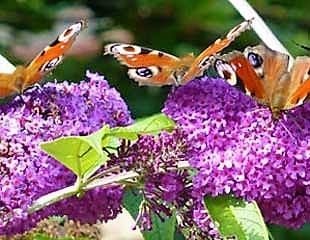
Known as the" Butterfly Bush" butterflies and pollinators are drawn to its aromatic flowers. This name is not an exaggeration.
Buddleia is an easy-to-grow, summer-flowering shrub. A popular variety widely sold, B. davedii, which can grow up to 5 meters, taking up a good amount of space in the border.
Although some varieties can get large, growers have been breeding patio-sized varieties. It's best to check the label carefully. Only the compact varieties of Buddleia are suitable for growing in containers.
Perovskia
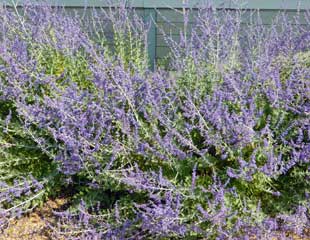
Lots of blue and mauve plants attract bees, such as lavender and nepeta, as does Perovskia common name Russian Sage. Although not clear from this image, there were masses of bees on the blue flowers of the Perovskia. It looks very good when planted alongside a blue-painted exterior/fence/seaside gardens.
An easy-to-grow perennial with silver, aromatic leaves and lovely spikes of blue flowers. Russian Sage is drought-tolerant, likes dry growing conditions and a sunny spot, and will reward with a cloud of blue and bees.
Monarda
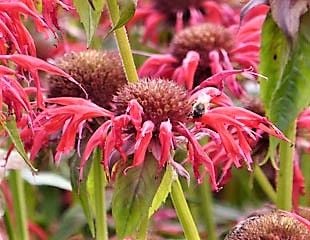
Common name is bee balm. Monarda is a herbaceous perennial. It has fragrant flowers, which attract bees and pollinators.
It has nectar-rich blooms, which are aromatic leaves. It is also known as Bergamot because of its fragrance.
The only drawback to this stunning perennial is that it tends to be short-lived. This means it needs replacing every few years or you can lift and divide it.
Perennial Cornflower
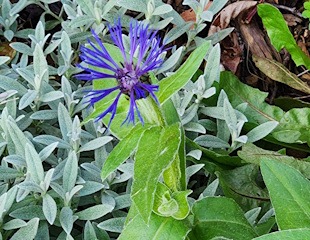
Centaurea montana, a simple perennial with blue flowers. Not my favourite plant I have to admit, but it is the bees' favourite. It self-seeds around, and every time I think about pulling some out, the bees settle on it. And incidentally, Goldfinches like the seeds, so it says.
I took this image in early November, and it's still flowering. It's been in flower around the garden since late spring. It's very hardy, grow anywhere, and is a deciduous perennial.
Herb oregano
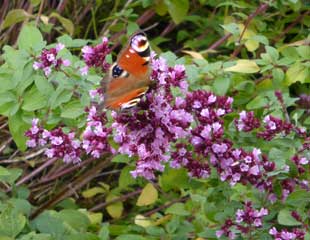
Another top plant for pollinators. Oregano is an aromatic herb that is very attractive to butterflies and pollinators. It is a perennial, and keeps its woody stems all winter. Cut back in the spring, allowing the fresh growth to come through.
Oregano is a tough, grow-anywhere plant. It is tolerant of most conditions and fully hardy. It tends to sprawl in the border, and can be checked by the Chelsea Chop. Illustrated is Origanum vulgare, great for pollinators and cooking. Oregano is suitable for growing on a balcony, and you can grow it in a container.
Lavender
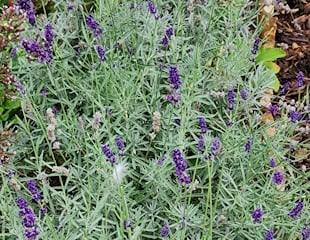
Another aromatic plant attractive to bees and butterflies is lavender. When considering the best plants for bees, Lavender has to come into the mix. Lavender is a Mediterranean-type plant, which means it likes a sunny spot with dry, well-drained soil.
I notice that even when the flowers are fading, the bees still come. Standard gardening advice is to trim back after flowering. I don't recommend this for a wildlife-friendly garden. I took the image in late September 2025. A dry summer followed by a wet early autumn produced a strong second flush of flowers, much enjoyed by the bees, right through into November.
Nepeta
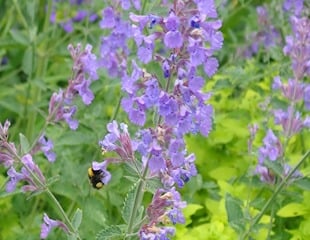
If your garden tends to have heavy clay soil, which is prone to water-logging in the winter, Lavender will not tolerate these conditions.
The better option is to grow lavender in containers or substitute Nepeta, which will attract its fair share of pollinators, (and, unfortunately, cats!) Both would be suitable for growing on a balcony.
Nepeta is an easy-to-grow aromatic, summer-flowering perennial. It produces clouds of soft blue and always has a good collection of bees on it all summer long.
Sulpher Clover

All clovers are bee friendly. This is Sulpher Clover, Trifolium ochroleucon, another excellent plant for pollinators and also an English native plant. Don't worry about the title "Clover", this is a well-behaved clump-forming Clover in a lovely golden yellow which, like all clovers, is ideal for bees and butterflies. It is easy to grow, reaching around .45m and is suitable for sun or dappled shade. A fully hardy, herbaceous perennial, so it will return each year and die back over winter.
It looks lovely as illustrated here, planted with blue campanulas and purple geraniums.
Agastache
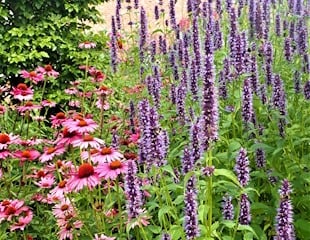
I recently bought several Agastache at a local show, which came with their own bees on them. Agastache have spikes of blooms and aromatic foliage. Agastache flowers best when planted in a sunny spot, and although generally hardy, it is a good idea to mulch over winter.
Illustrated is a bee-friendly planting combination of Agastache and Echinacea taken at RHS Bridgewater, a great garden to visit.
An easy-to-grow, herbaceous perennial which will die back over winter and return in the spring. To ensure it returns, do not plant Agastache in winter wet conditions.
Foxgloves

Digitalis, our common native foxglove, is good for bees, especially bumble bees.
The tubular shape of the flower allows the bee to climb inside to collect the nectar and at the same time, gather pollen.
Foxgloves are easy to grow biennials, which means they set seed and grow one year flower the next. In practical terms, this is not a problem because they self-seed around the garden and after the second year they are continuously in flower from all the seedlings.
Tolerant of most growing conditions and a great bee-friendly plant.
Plants for Bees and Butterflies in shade and wet
Persicaria
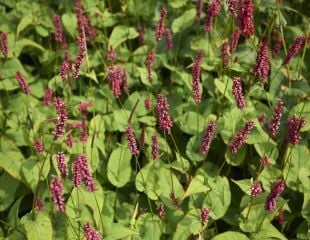
Many of our favourite bee-friendly plants need full sun, so here is a welcome exception. Persicaria amplexicaulis will grow in semishade and in moisture-retentive, damp or even boggy soil.
It is loved by honeybees and pollinators, as the video below shows. It is a fairly vigorous perennial, which may drop its leaves in winter in cold areas, although it is very hardy and classified as H7. It makes a dense clump of ground cover and flowers for a long time through midsummer to early autumn.
English Ivy
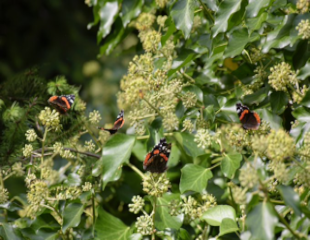
This is an English native plant which everyone ( see RHS and Surry Wildlife trust) is talking about because it is so good at supporting wildlife.
Hedera Helix, looks nothing special, but when mature, it produces flowers and berries which support a wide range of wildlife, particularly late in the year before hibernation. The nectar and pollen are food for insects, including bees, hover-flies, butterflies and wasps. The berries have high fat content, which is loved by birds, and the plant itself provides shelter for insects and small mammals.
Videos of our Most bee and butterfly friend plants
More pages of wildlife, bee and butterfly planting
Of course, there are many more plants attractive to bees and butterflies. There are several more pages on the Sunday Gardener with more ideas and information. - see below and check out:-
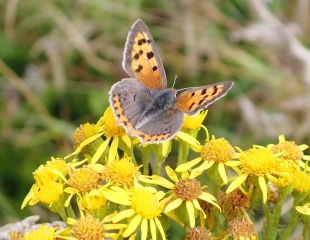
Wildlife friendly plants
10+ butterfly friendly plants with images and growing advice

Plants for bees
10+ Plants for Bees plus the science behind the planting
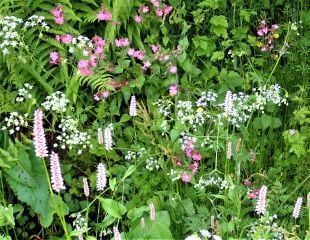
Create a wild garden
Create a wild area in the garden and let nature in.

Help the bumble bees
Planting for bumble bees what we can do to help.
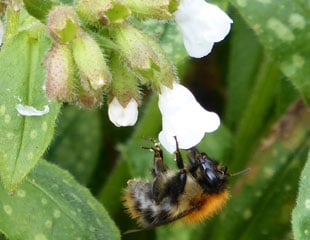
Spring flowers for bees
Early nectar is important - plant ideas to feed the bees.
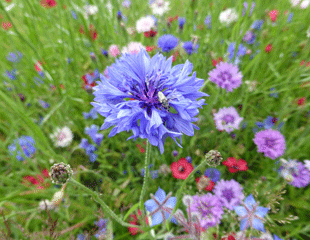
Grow wildflowers
Create a wildflower area easy to grow from seed
